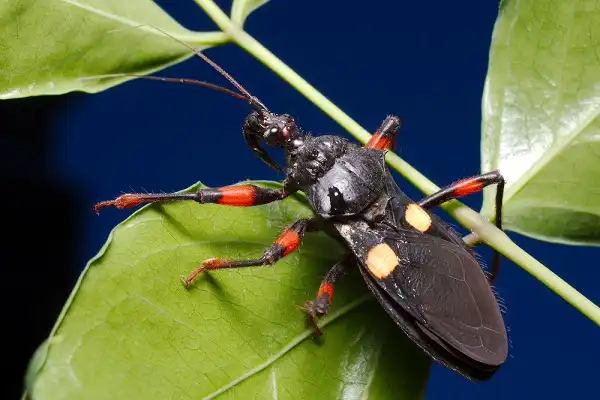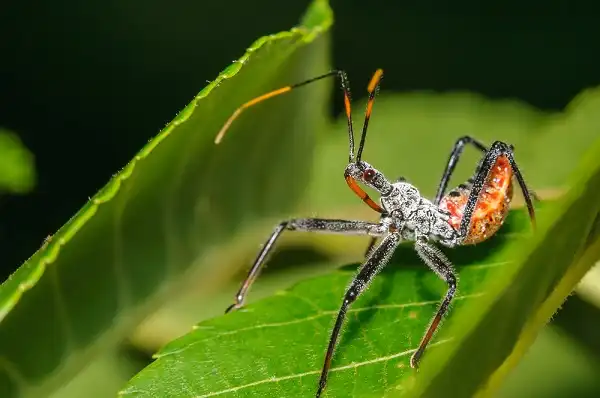Have you ever noticed the small, slender bug with a long snout sitting motionless on your wall or window? It might have been an Assassin Bug, also known as a Kissing Bug. These remarkable creatures are feared by many thanks to their formidable hunting expertise and painful bite. But they’re far more than just fierce predators—they play an important role in the environment that helps maintain the food chain while decreasing populations of unwanted species. Learn more about these fascinating bugs and their place in nature.

Assassin Bug Description
The Assassin Bug is a fascinating and unique insect that is easily recognizable by its long, slender body and elongated snout. These bugs come in a variety of colors, from brown to green to black, and they often have distinctive markings or patterns on their bodies. They have powerful, grasping legs that allow them to cling to surfaces and move with precision. One of the most distinctive features of the Assassin Bug is their long, piercing snout, which they use to inject a lethal dose of venom into their prey. Their size and physical characteristics vary depending on the species, but most are characterized by a long, pointed snout known as a rostrum. This specialized structure allows them to inject their prey with venom and immobilize them for feeding. They also have long, slender legs that are adapted for capturing and holding onto prey. One unique physical characteristic of some species of Assassin Bugs is their ability to camouflage themselves by blending in with their surroundings. For example, species like the masked hunter and the ambush bug have evolved coloration and patterns that allow them to blend in with their surroundings, making them difficult to detect by potential prey.
Assassin Bug Habitat
The Assassin Bug is a fascinating insect that can be found in various habitats across the globe, such as tropical forests, deserts, and grasslands. These versatile bugs can adapt to different environments, making them a common sight in many regions. Assassin Bugs thrive in warm and humid conditions and are often found in areas with abundant vegetation. They are known to inhabit leaf litter, tree trunks, and crevices in rocks and buildings. In some cases, they even make their homes in the nests of other insects. Despite their adaptability, certain species of Assassin Bugs are highly specialized and prefer specific environments. For example, the cone-nosed Assassin Bug is commonly found in areas with rodent burrows, while the wheel bug is typically found in wooded areas. Assassin Bugs are also known to be active hunters, which means they are most commonly found in areas with plenty of prey. For example, in agricultural regions, they can be found in fields and orchards, where they prey on pests that damage crops. In addition to their diverse habitat range, Assassin Bugs are also known for their unique life cycle. Some species lay their eggs on the undersides of leaves, while others bury their eggs in the soil. Once hatched, the young Assassin Bugs go through several molts before reaching adulthood.
Assassin Bug Diet
Assassin Bugs are carnivorous insects that have a diverse diet, preying on a variety of insects and other small arthropods. Their diet typically includes mosquitoes, flies, beetles, caterpillars, spiders, and even other Assassin Bugs. These predatory insects are ambush hunters and will often patiently wait for their prey to come to them. Once they have spotted their prey, they will stealthily approach and impale the unsuspecting victim with their sharp, pointed snout. The venom injected is a lethal neurotoxin that quickly paralyzes the prey, allowing the Assassin Bug to easily feed on its immobilized victim. While Assassin Bugs are known for their voracious appetite, they are also highly selective in their food choices. They prefer to prey on insects that are small enough to be easily manipulated and subdued by their venomous bite. Additionally, they tend to avoid preying on bees and other pollinators that are important for plant pollination.

Assassin Bug Size
Assassin Bugs, also known as predatory bugs, are a diverse group of insects that vary in size depending on the species. The smallest species of Assassin Bugs, such as the tiny pirate bug, measure less than 1/16 of an inch, while larger species like the wheel bug can grow up to 1.5 inches in length. Despite their small size, Assassin Bugs are formidable predators that are capable of taking down prey that is much larger than themselves. For example, some species of Assassin Bugs have been known to prey on spiders, beetles, and even small reptiles like lizards. Overall, the diverse size and physical characteristics of Assassin Bugs make them an interesting subject for scientific study, and their unique adaptations and hunting strategies highlight the intricacies of the natural world.
Assassin Bug Lifespan
Assassin Bugs, also known as Reduviidae, are a fascinating group of predatory insects that display an impressive array of adaptations and survival strategies. The lifespan of Assassin Bugs varies depending on the species, environmental factors, and available prey, however, most species have a lifespan between 6 months and a year. The lifespan of Assassin Bugs is dependent on multiple factors including environmental conditions, availability of prey, and species. Despite their relatively short lifespan, Assassin Bugs play a crucial role in regulating pest populations, providing a service that is critical to their ecosystem and the larger food web. The intricate lifecycles and fascinating behaviors of these predatory insects make them an important subject for scientific study and understanding.
Assassin Bug Behavior
Assassin Bugs, also known as Reduviidae, are intriguing insects that exhibit fascinating behaviors and hunting strategies. These predatory bugs are known for their powerful front legs that are specialized for capturing and holding onto prey, as well as their ability to camouflage themselves to blend in with their surroundings. Assassin Bugs are skilled hunters that use various tactics to capture their prey. Some species, like the masked hunter and ambush bug, patiently wait for their prey to come within striking distance before making a swift attack, while others, like the wheel bug, actively pursue their prey. Interestingly, Assassin Bugs are often found in agricultural settings, as they play an important role in regulating pest populations. They are a natural biological control for a variety of agricultural pests and can help reduce the need for harsh pesticides.

Assassin Bug Speed
Assassin Bugs, also known as Reduviidae, are renowned for their impressive hunting abilities and unique behaviors. These predatory insects have evolved to be swift and agile, specializing in capturing prey with speed and precision. Assassin Bugs have a remarkable speed when they need to capture prey. They are capable of moving their front legs at incredible speeds, snatching their prey in mere milliseconds. Some species, like the wheel bug, can move at lightning-fast speeds, traveling up to 4.5 feet per second. This incredible speed and agility allow them to catch their prey before it can escape. Assassin Bugs are an impressive group of insects with unique physical and behavioral adaptations. Their incredible speed, powerful beaks, and venomous bites make them formidable predators capable of taking down much larger prey. Their role in pest control and their intricate hunting strategies highlight the complexities of the natural world, making them an important subject for continued study and exploration.
Assassin Bug Hunting
Assassin Bugs are highly skilled predators that are well-known for their impressive hunting abilities. These fascinating insects have evolved to become experts in capturing prey with speed, precision, and agility. In addition to their speed, Assassin Bugs also demonstrate unique behavioral adaptations that help them hunt. Some species, like the thread-legged bug, have evolved the ability to mimic the movements of potential prey by using their legs to replicate the twitching movements of an injured insect. Assassin Bugs also have powerful beaks and venomous bites that allow them to capture and subdue prey that is much larger than themselves. Their beaks are specially adapted to inject venom, which paralyzes their prey within seconds. Once their prey is immobilized, Assassin Bugs can consume it at their leisure.
Assassin Bug Life Cycle and Reproduction
The Assassin Bug life cycle typically begins with eggs which can take up to a few weeks to hatch. After hatching, the immature bugs proceed through various developmental stages known as instars before becoming adult bugs. During these early stages, the Assassin Bug individuals are voracious eaters and are often able to consume prey much larger than themselves. Interestingly, some Assassin Bugs display a unique form of parental care in which the female lays her eggs on plant material and covers them with a layer of antimicrobial secretion. The female then guards the eggs which will hatch in a few week’s time. Once the eggs hatch, the young Assassin Bugs will go through a series of developmental stages called instars, during which the adult female will continue to provide protection for the eggs and immature offspring.

Conclusion
Assassin Bugs are a remarkable group of insects that have evolved amazing physical and behavioral adaptations to make them formidable predators. Their incredible speed, powerful beaks, and venomous bites allow them to swiftly capture their prey with ease. They also play an important role in controlling pest populations, reducing the need for harmful chemical pesticides in agricultural settings. Furthermore, their complex behaviors and hunting strategies make them fascinating subjects for continued scientific study and exploration. By understanding Assassin Bugs better, we can continue to appreciate the intricate beauty of nature and its many creatures.
Frequently Asked Question

